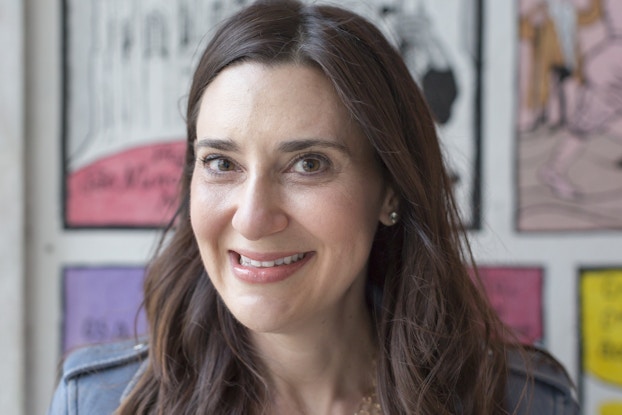
For Jodi Goldberg, it was how her son played with his 3D pen, tackling the art of creation with exploratory abandon, that awakened Google’s head of retail to the value of business innovation that’s fueled by experimentation.
And for Eoin Comerford, the phrase “overtaxed mediocrity” is what struck a resonant chord with the CEO of Walmart’s Moosejaw chain, leading to the outdoor retailer’s pared-down, shopper-centric revamp.
Indeed, inspiration comes in many forms, and can impel executives to shift gears to drive business in seemingly unforeseen ways, retailers told CO—.
Going beyond the glittering generalities that often turn discussions of inspiration into weightless abstractions, here, Goldberg; Comerford; Mike George, CEO of QVC/HSN parent company Qurate Retail Group; and Stella & Dot founder Jessica Herrin share concrete examples of how a flash of inspiration catalyzed business.

Walmart’s Moosejaw CEO: The revelation of ‘overtaxed mediocrity’ ignites change
Walmart nominated Comerford, who heads up Moosejaw, the outdoor retailer it purchased in 2017, to attend Harvard Business School’s leadership training program by well-known professor Frances Fei.
“I remember when I got the note saying I’d been nominated, I thought, ‘I need this like I need a hole in the head’ — especially in the run up to holiday,” he said, noting, the frantic make-or-break selling season for retailers.
Later he was grateful that he did. The lessons learned yielded bona fide business returns for Moosejaw.
For Comerford, Fei’s talk on “overtaxed mediocrity” struck a particularly resonant chord. “The point was, if you try to do everything or compete in every facet of business, you end up being mediocre in everything. You have to decide: Look at your core customer and find out what they want. Put your eggs in that basket and really overinvest in one area to truly differentiate yourself,” he said. “In order to do that, you have to be willing to cede something. I’ve taken this as a personal mantra to do less better.”
Moosejaw turned a harsh light on its own business to suss out the mediocrities according to the folks who matter most: its shoppers. The outdoor retailer offered consumers $10 to rank the nine core tenets of its business (as defined by Moosejaw), in order of importance to them. The results from about 50,000 respondents came as a surprise. “Some of the things we thought were important they didn’t,” and vice versa, Comerford said.
For one, online product information specificity and the ability to view an item from multiples angles, like seeing the back of a sports bra, ranked “way up there ahead of site speed, our returns policy,” he said. “While product videos were at the bottom of the list, although we had invested a lot in product videos,” he said.
The exercise birthed Moosejaw’s “product-perfection strategy,” which is informed by the seemingly simple question: “What does perfection look like in the eye of the consumer?” Comerford said.
Shedding the business of “overtaxed mediocrity” simplified Moosejaw’s focus, too. “In terms of do better less, we used to have 10 strategic priorities for the year, now we have five,” he said.

Google’s head of retail: Inspired by the ‘horizontal thinking’ of a child
Google’s Goldberg draws inspiration from how her two children, ages six and 10, instinctively tackle a project the way the CEO of a tech startup would, which reflects their “horizontal thinking,” said the head of industry, retail, for the tech giant.
Broadly speaking, horizontal thinking solves problems via a nonlinear and creative approach, whereas its opposite, vertical thinking, takes an analytical, careful and precise approach to finding solutions.
In today’s business landscape, horizontal thinking echoes Silicon Valley-informed tech culture, which favors accelerated product iteration, experimentation and a fail-fast mentality, in the service of incubating successful ideas.
“I’m conditioned to think about solving from a vertical thinking standpoint: Let’s define a process and let’s define the problem, let’s think about all the pieces within it,” Goldberg said. While vertical thinking is valuable and effective, “what I’ve noticed with my kids is this horizontal thinking, where they’re not afraid to jump right in and tactically try to solve a problem, and start prototyping to see what works and what doesn’t,” she said, noting the way her 10-year-old son plays with his Scribbler 3D pen. “I’ve tried to really embrace that in how I conduct myself and lead my team, and it’s been refreshing,” she said.
Embracing horizontal thinking, or thinking like her kids, has enriched Goldberg’s collaborative work with startups, she said. “At Google, I have an opportunity to work with these disruptive, newer e-commerce companies, and they do a lot of horizontal thinking, which allows them to move quite fast to iterate and get a tight product feedback loop, so they are able to bring new products out, and quickly make them better and make sure they’re really answering a consumer need, versus being only stuck in that vertical line of thinking,” Goldberg said. It’s about “just digging in and thinking more creatively.”
Look at your core customer and find out what they want. Put your eggs in that basket and really overinvest in one area to truly differentiate yourself.Eoin Comerford, CEO, Moosejaw
Innovate
Whether it's a pandemic or a lesson learned in everyday life, successful businesses always find ways to innovate to stay relevant and thriving. Read on for more ways businesses are pivoting.

CEO of Qurate Group (QVC/HSN) on the lessons inspired by selling vacuums door to door
One of Mike George’s first jobs as a teenager was selling vacuum cleaners door to door. “I only stuck with it for a few months, but it helped shape some of my core beliefs about business and retail,” said the CEO of Qurate Retail Group, which owns home shopping networks HSN and QVC.
“At each house, we would turn up the pressure to get the quick sale, using lots of overblown promises and stunts. Surprisingly, I was good at it, despite my generally soft-spoken nature. But I didn’t feel good about it,” he told CO—. “I wasn’t comfortable with the hype. That experience taught me that authenticity and integrity matter. I realized that I wanted to do something I believed in.”
The job informed George’s thinking about how to market merchandise. Eschewing the promotional gimmicks to nab shopper dollars that defined his door-to-door selling experience, George came to privilege a strategy that taps storytelling to illustrate the value of a product to consumers, and win their loyalty long-term. “Today, I’m proud to lead a retailer that engages customers in highly trustworthy, story-rich experiences, featuring truly special products at compelling values,” George said. “We focus on building long-term relationships, and as a result, our loyalty and repeat purchase rates are the envy of our industry.”

Stella & Dot founder: The ‘lightbulb moment’ that ‘changed everything’
Casual conversations tend to spark lightbulb moments for Jessica Herrin, CEO and founder of DTC brand Stella & Dot, where 30,000 “ambassadors” sell jewelry to consumers ( think Avon lady for the digital age.) One such chat proved invaluable to the business she founded in 2004 via a home-selling model.
Herrin credits the brand’s big strategic pivot last year to an off-the-cuff remark by a Stella & Dot ambassador. “I remember being at a bar in Kansas talking to our sellers, and there was a young, twentysomething brand ambassador” among them, she said. “She was asking me a question and I said, ‘There’s a [Stella & Dot] guide you can read online and it will have all the answers to your questions, you just log in.’ She looked at me like, ‘I’m not logging in. I don’t log in. I’m never logging in.’ I looked at her and realized, she’s right.”
Based on that moment, “we changed everything,” she said.
For Herrin, the twentysomething’s comment seemed to render Stella & Dot’s ambassador training methods out of step with how millennials and Generation Z not just consume content, but navigate their lives today.
So it shifted from training via classroom style courses to its “Self Made University” platform, “where it’s all done with video and community and fun,” she said.
But the ambassador’s comment led to even bigger changes at the brand, shifting her attention to its waning home-selling events, and to how consumers’ habits have radically changed with the dominance of digital culture.
“Are consumers going to travel to a home selling event? That’s not happening anymore, and it’s not coming back,” Herrin said. “As this woman ages into our world, everything is going to change, [including] how they’re connecting with people. Everything is basically irrelevant because this is no longer social behavior.”
So last year, the disruptor disrupted its own business model, moving ambassadors from home-selling events to a “social selling,” digital model via online and mobile platforms. That pre-COVID-19 pivot from in-person events to virtual platforms, whereby sellers interact with customers online, turned out to be eerily prophetic, unwittingly future-proofing the business for a pandemic-changed world.
Amid the pandemic’s economic fallout, Stella & Dot is also signing on new ambassadors seeking a way to make money as quickly as possible.
“We’re giving the modern woman a way to learn and earn on her own terms,” Herrin said.
CO—is committed to helping you start, run and grow your small business. Learn more about the benefits of small business membership in the U.S. Chamber of Commerce, here.








